Museums and Exhibitions is a multidisciplinary project that aims to bring together current research on museums, learning, technology and user-centered design. It has two main research goals. First, we want to investigate how the expressed educational goals of museum exhibitions can be accomplished through the use of modern computer technologies. Second, we want to involve end-users (i.e., visitors) throughout the entire exhibition production cycle and evaluate how their work influences the resulting exhibitions. Our hypothesis is that such a design partnership will have similar positive effects to those that have been documented elsewhere in computer application design.
During the last couple of decades, the role of museums
has successively shifted. Historically, museums have largely been concerned
with the collecting, preserving and exhibition of cultural artifacts,
while today many of them additionally are involved in the production of
educationally oriented entertainment experiences [4]. This shift is largely
due to the increasing competition (and resulting decrease in the number
of visitors) from other sources of entertainment, like cinemas, amusement
parks, computer games and television. In response, many museums are attempting
to maximize their entertainment potential while retaining their unique
features; namely the combination of an educational agenda with the availability
of genuine artifacts. Thus, much of today's museum research is involved
with the documentation of the visitor experiences and learning processes
that take place in museums (e.g., [2]). This has resulted in guidelines
for how to combine physical, socio-cultural and personal aspects of exhibitions
in order to create efficient learning environments.
However, such guidelines rarely include the usage of
technology. The most common use for computers in museums is as multimedia-based
automated tour-guides (e.g., [7], [6]) or, in art galleries, as the supporting
technology in a piece of artwork, e.g., Mimetic Dynamics (http://www.kunst.no/mimdyn/)
and Atmosphere (http://acg.media.mit.edu/projects/atmosphere/). However,
we believe that it is possible to design technology that more closely
supports the educational aspects of exhibitions. Related work in this
domain includes the Boston Computer Museum's Virtual Fishtank (http://www.virtualfishtank.com/)
and the interactive stations in the London Science Museum's Wellcome Wing
[5]. However, these exhibitions are typically rather inflexible and difficult
to adapt in response to visitor feedback. As a result, we are developing
software that can facilitate "living exhibitions", i.e., exhibitions
that can be modified while remaining on display. Our work has resulted
in a two long-term exhibitions: one at the Museum of Natural History and
one at the Museum of Science and Technology (both in Stockholm). These
exhibitions are currently under evaluation, but our initial analysis suggests
that the approach is feasible.
Few museums are actively involving visitors in the
production of exhibitions. Rather, the visitor's role in the design process
is largely seen as that of an informant (commenting on existing exhibitions)
or as a tester (commenting on exhibition prototypes). However, research
in human-computer interaction has shown that design partnerships between
system developers and end users can produce innovative applications that
closely meet the end-users' goals (e.g., [3], [1], [8]). At CID, we have
been actively involved in the adoption of such design methods to the school
domain [9] and we hypothesize that these benefits will transfer to the
museum domain as well. Thus, we are currently preparing a series of workshops
that will bring together representatives of a visitor target group (in
this case, high school students), exhibition designers, computer scientists
and educational experts. The goal for these workshops is to produce an
exhibition design that will then be implemented and exhibited at the Museum
of Science and Technology in Stockholm.
References
1. Beyer, H., and Holtzblatt, K. Contextual Design: Defining Customer-Centered
Systems, Morgan Kaufmann, 2002.
2. Falk, J. H., and Dierking, L. D. Learning from Museums. Visitor Experiences
and the Making of Meaning. AltaMira Press, 2000.
3. Greenbaum, J. and Kyng, M. Design at work. Cooperative design of computer
systems. Lawrence Erlbaum, 1991.
4. Hooper-Greenhill, E. (ed.) The Educational Role of the Museum. 2nd
edition. Routledge, 1999.
5. London Science Museum. Wellcome Wing. Guidebook, 2001.
6. Rayward, W. B., and Twidale, M. B. From Docent to Cyberdocent: Education
and Guidance in the Virtual Museum. University of Illinois Technical Report
ISRN UIUCLIS 1999/8.
7. Samis, P. S. Points of Departure: Curators and educators collaborate
to prototype a "Museum of the Future". In Proceedings of ICHIM
2001, 623-637.
8. Schuler, D., and Namioka, A. Participatory Design. Principles and Practice.
Lawrence Erlbaum, 1993.
9. Taxén, G., Druin, A., Fast, C., and Kjellin, M. KidStory: A
Technology Design Partnership with Children, Behaviour and Information
Technology, 20(2) April-March, 2001, 119-125.
Uppdaterade 2003-03-07
CID 1996-2000 | About this website | cid-webmaster@nada.kth.se
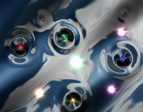
ToneTable - an interactive mixed reality
exhibit.
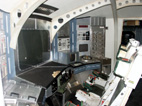
The cock pit at the exhibit “Space Adventure”
at the Swedish Museum of Natural History in Stockholm.
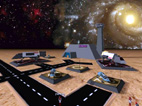
A virtual representation of the exhibit “Space
Adventure” at the Swedish Museum of Natural History in Stockholm.
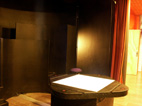
Interior from the installation “Well of Inventions”
at the Museum of Science and Technology in Stockholm.

Mixed-reality techniques in the installation “Well
of Inventions” at the Museum of Science and Technology in Stockholm.
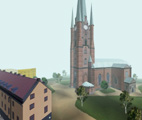
The history of Stockholm in a virtual exhibit. This
is Klara Kyrka in 1899.
